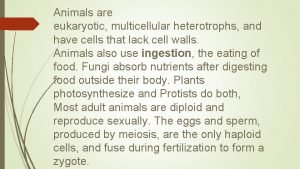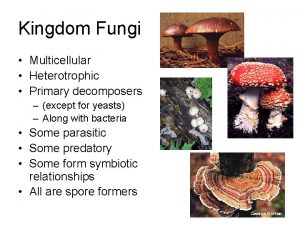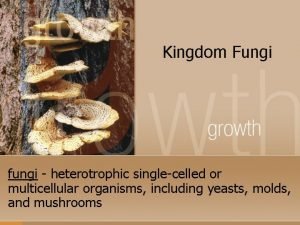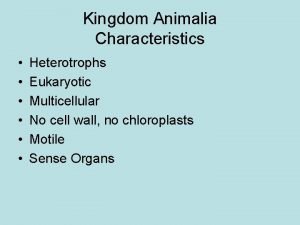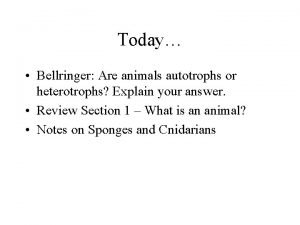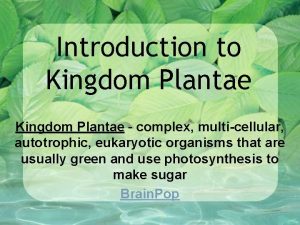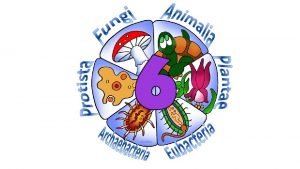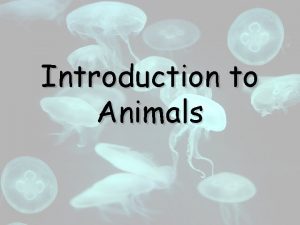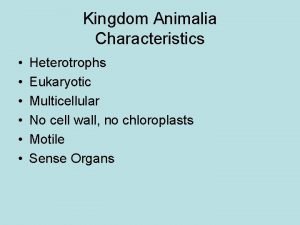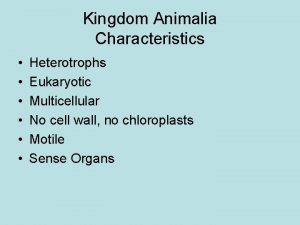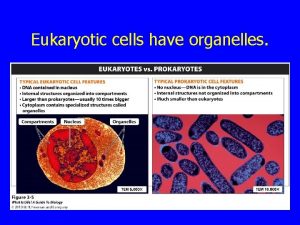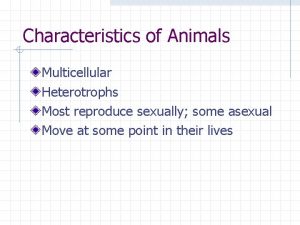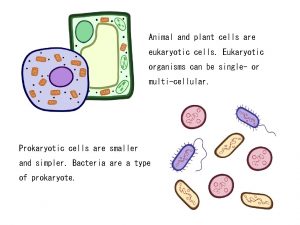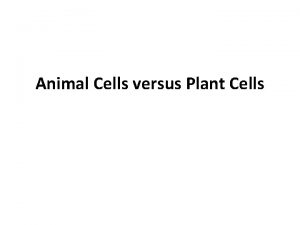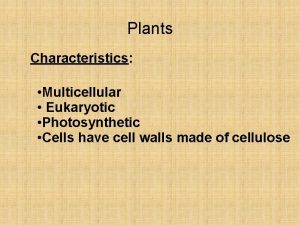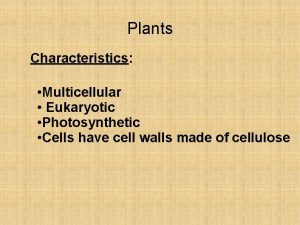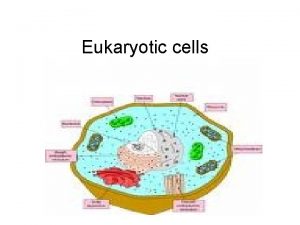Animals are eukaryotic multicellular heterotrophs and have cells














- Slides: 14

Animals are eukaryotic, multicellular heterotrophs, and have cells that lack cell walls. Animals also use ingestion, the eating of food. Fungi absorb nutrients after digesting food outside their body. Plants photosynthesize and Protists do both, Most adult animals are diploid and reproduce sexually. The eggs and sperm, produced by meiosis, are the only haploid cells, and fuse during fertilization to form a zygote.

The zygote divides by mitosis to form a hollow ball of cells called a blastula. One side of the blastula folds in and cells become rearranged to form a gastrula that establishes three embryonic layers. 1. Endoderm forms a lining of the future digestive tract. 2. Ectoderm forms an outer layer that will give rise to the skin and nervous system. 3. Mesoderm forms a middle layer that will give rise to muscles and most internal organs.

After the gastrula stage, many animals develop directly into adults. Other animals develop into one or more larval stages. A larva is an immature individual that looks different from the adult animal. A larva undergoes a major change in body form, called metamorphosis, and becomes a reproductively mature adult.

Figure 18. 1 B Sperm Seastar Reproduction 2 1 Meiosis Zygote (fertilized egg) Egg 3 Eight-cell stage Adult 8 Metamorphosis 4 Blastula (cross section) Digestive tract 5 Ectoderm Larva 7 Endoderm Internal sac 6 Later gastrula (cross section) Early gastrula (cross section) Future mesoderm Key Haploid (n) Diploid (2 n)

INVERTEBRATE EVOLUTION AND DIVERSITY Classified by symmetry, presence of true tissues, number of embryonic layers, presence of a body cavity, and how the embryo forms a digestive tract.

Symmetry Animals that have radial symmetry have a top and bottom but lack back and front or right and left sides. An imaginary slice through the central axis divides them into mirror images. Animals with bilateral symmetry have mirrorimage right and left sides and a distinct head, or anterior end, tail, or posterior end, back, or dorsal, surface, and bottom, or ventral, surface.

Figure 18. 3 Type of symmetry Radial Embryonic development: two or three tissue layers Embryonic development: body cavity Ectoderm Endoderm Body cavity Bilateral Mesoderm

§ Tissues are collections of specialized cells that perform numerous functions and can form organs. Sponges are the only animals that lack true tissues. Most animals have embryonic layers of tissue. Some animals have only ectoderm and endoderm. Most animals have ectoderm, mesoderm, and endoderm. Animals with three embryonic layers may have a body cavity, a fluid-filled space between the digestive tract and outer body wall that cushions internal organs and that enables them to grow and move independently of the body wall. In soft-bodied animals, fluid in the body cavity forms a hydrostatic skeleton.

Figure 18. 3 Embryonic development: body cavity (helps protect organs from injury) Body covering (from ectoderm) Body cavity Digestive tract (from endoderm) Tissue layer lining body cavity (from mesoderm)

Animals with three tissue layers can be separated into two groups based on details of their embryonic development. For example, the opening formed during gastrulation develops into the mouth in protostomes and anus in deuterostomes. Figure 18. 3 Embryonic development: tissue layers Two layers (some animals) Gastrulation Ectoderm (outer layer) Endoderm (inner layer) Three layers (most animals) First opening in embryo Future anus Mesoderm Future mouth Future digestive Future anus Future mouth tract Deuterostome Protostome (“first mouth” in Greek) (“second mouth” in Greek)

One diagram of evolutionary relationships uses morphology and molecular biology to construct a phylogenetic tree. This tree distinguishes between sponges and eumetazoans (animals with true tissues), animals with radial or bilateral symmetry (bilaterians), and which have two branches, lophotrochozoans named for a feeding part called a lophophore in some and trochophore larvae as well as Ecydysozoans, which shed their exoskeletons Deuterostomes share larval development and include echinoderms and chordates

Figure 18. 4 No true tissues Sponges Radial symmetry Cnidarians Ancestral colonial protist Ecdysozoans Bilaterians Bilateral symmetry Lophotrochozoans Eumetazoans True tissues Flatworms Molluscs Annelids Nematodes Arthropods Deuterostomes Echinoderms Chordates

For terrestrial ecosystems, we will examine Annelids and Arthropods in more detail. Phylum Annelida One class of Annelids is largely Terrestrial. Class Oligochaeta

Phylum – Arthropoda Two classes: Class – Arachnida Class – Insecta
 All animals are multicellular heterotrophs
All animals are multicellular heterotrophs Antigentest åre
Antigentest åre Eukaryotic vs prokaryotic cells
Eukaryotic vs prokaryotic cells Prokaryotic vs eukaryotic cells venn diagram
Prokaryotic vs eukaryotic cells venn diagram Cuál es la diferencia entre la célula animal y vegetal
Cuál es la diferencia entre la célula animal y vegetal Which organisms are prokaryotes
Which organisms are prokaryotes Fungi are eukaryotic heterotrophs
Fungi are eukaryotic heterotrophs Multicellular heterotrophic
Multicellular heterotrophic Are fungi multicellular or unicellular
Are fungi multicellular or unicellular Kingdom
Kingdom Are cnidarians autotrophs or heterotrophs
Are cnidarians autotrophs or heterotrophs A multicellular autotrophic organism with vascular tissue
A multicellular autotrophic organism with vascular tissue Is archaebacteria unicellular or multicellular
Is archaebacteria unicellular or multicellular Similarities between prokaryotic and eukaryotic cells
Similarities between prokaryotic and eukaryotic cells Cytoskeletal protein
Cytoskeletal protein
